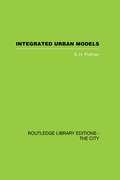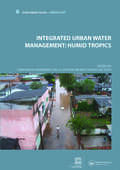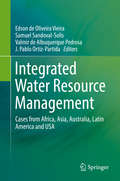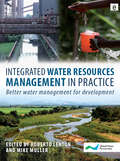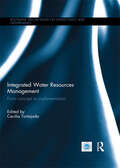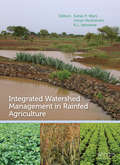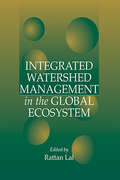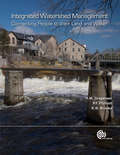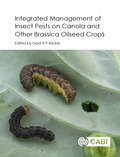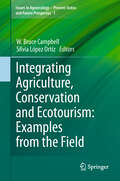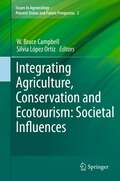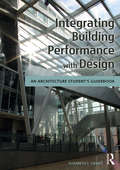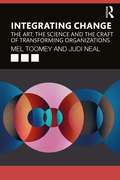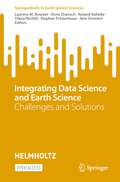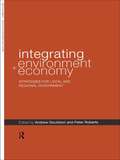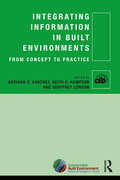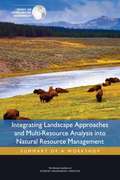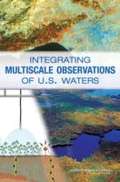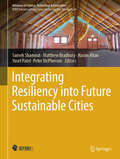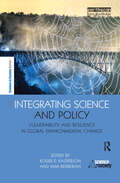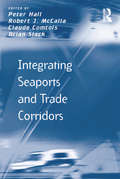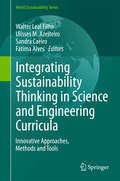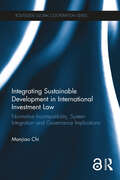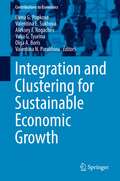- Table View
- List View
Integrated Urban Models Volume 1 (RLE: The City): New Research And Applications Of Optimization And Dynamics
by S. H. PutmanThis book was first published in 1983.
Integrated Urban Water Management: UNESCO-IHP (Urban Water Series)
by Jonathan N Parkinson; Joel A. Goldenfum Carlos E.M.TucciExcess water in the urban environment results in flooding,which causes structural damage, risks to personal safety and disruption to city life. Water is also a major contributory factor for disease transmission as well as being the medium for transport of many pollutants. These problems are of increasing concern due to climate changes and are parti
Integrated Water Resource Management: Cases from Africa, Asia, Australia, Latin America and USA
by Edson De Vieira Samuel Sandoval-Solis Valmir De Pedrosa J. Pablo Ortiz-PartidaThis book presents case studies that share important experiences regarding Integrated Water Resource Management (IWRM) in various countries. Following an introduction to theoretical concepts, responsibilities, and challenges, the subsequent chapters address, among other topics, an analysis of policies and regulations for water management in Brazil, the drivers that led California to adapt to the IWRM framework, and the international regulations for water markets and water banking in Australia and Chile. The implications of climate change for water resource systems in Mexico are discussed, as well as management strategies from California that could potentially serve as IWRM adaptation schemes in Mexico. Critical cases from Guanacaste (Costa Rica), and from Zayandehrud River Basin and Lake Urmia (Iran) are reviewed in terms of management practices and solutions. The book also provides an overview of the current availability and use of water resources in South Korea, and discusses the management of and international water law instruments for transboundary groundwater in Africa.
Integrated Water Resources Management in Practice: Better Water Management for Development
by Roberto Lenton Mike MullerBetter water management will be crucial if we are to meet many of the key challenges of this century - feeding the worlds growing population and reducing poverty, meeting water and sanitation needs, protecting vital ecosystems, all while adapting to climate change. The approach known as Integrated Water Resources Management (IWRM) is widely recognized as the best way forward, but is poorly understood, even within the water sector. Since a core IWRM principle is that good water management must involve the water users, the understanding and involvement of other sectors is critical for success. There is thus an urgent need for practical guidance, for both water and development professionals, based on real world examples, rather than theoretical constructs. That is what this book provides. Using case studies, the book illustrates how better water management, guided by the IWRM approach, has helped to meet a wide range of sustainable development goals. It does this by considering practical examples, looking at how IWRM has contributed, at different scales, from very local, village-level experiences to reforms at national level and beyond to cases involving trans-boundary river basins. Using these on-the-ground experiences, from both developed and developing countries in five continents, the book provides candid and practical lessons for policy-makers, donors, and water and development practitioners worldwide, looking at how IWRM principles were applied, what worked, and, equally important, what didn‘t work, and why. Published with the Global Water Partnership
Integrated Water Resources Management: From concept to implementation (Routledge Special Issues on Water Policy and Governance)
by Cecilia TortajadaThe book includes seventeen excellent researched and documented papers that reflect the diversity of thought, ideas and experiences related to IWRM. They draw from an extensive, inclusive and geographically representative range of theoretical propositions and practical examples. These include the implementation status of the IWRM concept at local, basin, regional and national levels; its appropriateness for the twenty-first century; main implementation gaps from the institutional, legal, policy, governance, management and technical viewpoints; the likelihood that IWRM’s entrenchment in laws, regulations and policies has led to smoother implementation and the reasons why that has been the case; reflexions on whether the attention given to IWRM is pushing other alternatives to the policy periphery; and the new conceptual constructions that can be put forward for discussion in the international arena.For the development and water communities it is imperative to debate and reach towards more illustrative conclusions regarding whether the promotion of the IWRM concept and its actual implementation status have been beneficial for development and how the notion could evolve to achieve this end. In-depth objective and constructive discussions, arguments, proposals and ideas are put forward for analysis by all interested parties. The book has the objective of fostering scholarly exchange, encouraging intellectual debate and promoting the advancement of knowledge and understanding of IWRM as a concept, as a goal per se and as a strategy towards development goals.This book was published as a special issue of the International Journal of Water Resources Development.
Integrated Watershed Management in Rainfed Agriculture
by Suhas P. Wani Johan Rockstrom Kanwar Lal SahrawatThis book provides a comprehensive presentation of the realization of improved rain fed agriculture yield in semi-arid and dry land areas. Besides techniques to improve the livelihood of small-scale farmers in developing countries, it includes examples and case studies for further support. The methods discussed have shown to be successful and economically remunerative in India and various African countries. Intended for professionals (investors, policy makers), researchers and (post)graduate students working on dry land and sustainable agriculture and water and natural resources management. Suited for courses in dry land agriculture, soil / water management and watershed development.
Integrated Watershed Management in the Global Ecosystem
by Rattan LalFocusing on the technical, social, and economic issues involved in watershed management, this interdisciplinary author team focuses on bettering land use practices and the condition of soil water resources.Integrated Watershed Management in the Global Ecosystem is a volume composed from an international symposium of the world's leading experts
Integrated Watershed Management: Connecting People to Their Land and Water
by Kenneth N. Brooks Hans M. Gregersen Peter F. FolliottGregersen, Folliott, and Brooks provide government agencies and other bodies with background information, factors to be considered, and procedures that facilitate organizing and guiding land and water use in concert with one another. The book can also serve as a reference for planning, monitoring, and implementing development efforts and natural resource management using the integrated watershed management approach. Annotation ©2008 Book News, Inc., Portland, OR (booknews.com)
Integrated management of Insect Pests on Canola and other Brassica Oilseed Crops
by Tao Li Peter Mason Kevin D Floate John Gavloski Hector Cárcamo Matthew P. Hill Harit K Bal Ronald E Batallas Tulsi Bhardwaj James D Blande Dhana Raj Boina G David Buntin Randall Brandt Surendra Dara Tim J Dumonceaux Robert H Elliott Maya Evenden Yaghoub Fathipour Kristopher L Giles Larry Grenkow Parwinder Grewal Rebecca H Hallett Vincent A Hervet Sari J. Himanen Heikki M.T. Hokkanen Jarmo K Holopainen Prashant Jha Janet J Knodel Sarina Macfadyen Ingeborg Menzler-Hokkanen Mohammad Ali Mirhosseini Christine Noronha Chrystel Olivier Francisco Rubén Badenes-Pérez S. Jesu Rajan Tom Royer Muhammad Sarwar Barbara Sharanowski Govinda Shrestha Juliana Soroka Rajagopalbabu Srinivasan Raj Kumar Thakur Sally Vail Leyun Wang R W Wanigasekara Chaminda De Weeraddana Tyler J Wist Zi-Hua ZhaoThis book comprehensively reviews current pest management practices and explores novel integrated pest management strategies in Brassica oilseed crops. It is essential reading for pest management practitioners and researchers working on pest management in canola and other Brassica crops worldwide. Canola, mustard, camelina and crambe are the most important oilseed crops in the world. Canola is the second largest oilseed crop in the world providing 13% of the world's supply. Seeds of these species commonly contain 40% or more oil and produce meals with 35 to 40% protein. However, its production has declined significantly in recent years due to insect pest problems. The canola pest complexes are responsible for high insecticide applications on canola. Many growers rely on calendar-based spraying schedules for insecticide applications. The diamondback moth Plutella xylostella and flea beetles Phyllotreta spp. (P. cruciferae and P. striolata)cause serious damage to canola. In the Northern Great Plains, USA, for instance, P. xylostella is now recorded everywhere that canola is grown. Severe damage to canola plants can be caused by overwintering populations of flea beetles feeding on newly emerged seedlings. Cabbage seed pod weevil (Ceutorhynchus obstrictus), swede midge (Contarinia nasturtii), and tarnished plant bug (Lygus lineolaris) are also severe pests on canola. Minor pests include aphids (cabbage aphid, Brevicoryne brassicae and turnip aphid, Hyadaphis erysimi) and grasshopper, Melanoplus sanguinipes. This book: · is the only single compiled source of information on integrated management of canola and other Brassica oilseed pests · presents the biology and management of all the major and minor pests of Brassica oilseed crops · is an essential source of information for applied entomologists, crop protection researchers, extension agents and stakeholders
Integrating Agriculture, Conservation and Ecotourism: Examples from the Field
by W. Bruce Campbell Silvia López OrtízIssues In Agroecology - Present Status and Future Prospectus not only reviews aspects of ecology, but the ecology of sustainable food production systems, and related societal and cultural values. To provide effective communication regarding status and advances in this field, this series connects with many disciplines such as sociology, anthropology, environmental sciences, ethics, agriculture, economics, ecology, rural development, sustainability, policy and education, and integrations of these general themes so as to provide integrated points of view that will help lead to a more sustainable construction of values than conventional economics alone. Such designs are inherently complex and dynamic, and go beyond the individual farm to include landscapes, communities, and biogeographic regions by emphasizing their unique agricultural and ecological values, and their biological, societal, and cultural components and processes.
Integrating Agriculture, Conservation and Ecotourism: Societal Influences
by W. Bruce Campbell Silvia López OrtízAgroecology not only encompasses aspects of ecology, but the ecology of sustainable food production systems, and related societal and cultural values. To provide effective communication regarding status and advances in this field, connections must be established with many disciplines such as sociology, anthropology, environmental sciences, ethics, agriculture, economics, ecology, rural development, sustainability, policy and education, or integrations of these general themes so as to provide integrated points of view that will help lead to a more sustainable construction of values than conventional economics alone. Such designs are inherently complex and dynamic, and go beyond the individual farm to include landscapes, communities, and biogeographic regions by emphasizing their unique agricultural and ecological values, and their biological, societal, and cultural components and processes.
Integrating Building Performance with Design: An Architecture Student’s Guidebook
by Elizabeth J. GrantIntegrating Building Performance with Design shows you the importance of designing for building performance early in your architectural design process. The book offers you simple tools and exercises, along with examples of built professional work and successful student projects illustrated by more than 100 full color images to help you with your work. Topics include site, solar orientation, thermal comfort, building enclosure, daylighting, passive heating and cooling, active heating and cooling, indoor air quality, stormwater, and rainwater harvesting.?
Integrating Change: The Art, the Science and the Craft of Transforming Organizations
by Judi Neal Mel ToomeyChange processes in organizations are time consuming, expensive, and often don’t create the intended results. This book creates a new way for leaders to relate to change from a place of deeper understanding. Based on years of research, consulting, and teaching, the models and frameworks described in this book have been applied successfully in organizations such as Johnson & Johnson, AT&T, IBM, Facebook, Charles Schwab & Company, and Accenture. The book provides breakthrough thinking to leaders who find themselves in the chaos of multiple, high amplitude changes that cannot be managed from an autocratic or even a participative mindset. The successful transformation of a human system does not require that people change who they are so much as it requires they become more of who they are—more like themselves. Change does not require new step-by-step models offered by an outside expert. It requires teaching people how to become model builders. As a result of this deeper transformation of mindset, not only will people in the organization be able to manage the particular change crisis facing them in the moment, they will develop a new relationship to change so that strategic thinking and breakthrough business outcomes become part of the organizational norm. This book will primarily appeal to experienced leaders, senior managers, and change agents who have learned that the textbook recipes for initiating or responding to change don’t work. It is also useful supplementary reading for students of organizational studies and leadership.
Integrating Data Science and Earth Science: Challenges and Solutions (SpringerBriefs in Earth System Sciences)
by Laurens M. Bouwer Doris Dransch Roland Ruhnke Diana Rechid Stephan Frickenhaus Jens GreinertThis open access book presents the results of three years collaboration between earth scientists and data scientist, in developing and applying data science methods for scientific discovery. The book will be highly beneficial for other researchers at senior and graduate level, interested in applying visual data exploration, computational approaches and scientifc workflows.
Integrating Environment and Economy: Strategies for Local and Regional Government
by Peter Roberts Andrew GouldsonIntegrating Environment and Economy provides a detailed and accessible examination of how integrated approaches enable economic and social activities to support environmental objectives. This is a key text for the many taught Masters courses covering the issues of environmental management and economic development Features of the book:* covers strong areas of undergraduate and postgraduate study* detailed practice-based case studies at both local and regional levels* up-to-date theory using real-life examples
Integrating Information in Built Environments (Cib Ser.)
by Adriana X Sanchez Keith Hampson Geoffrey LondonIn an increasingly globalised built environment industry, achieving higher levels of integration across organisational and software boundaries can lead to improved economic, social and environmental outcomes. This book is the direct result of a collaborative global network of industry and academic researchers spread across nine countries as part of CIB’s (International Council for Research and Innovation in Building and Construction) Task Group 90 (TG90) Information Integration in Construction (IICON). The book provides a broad view of some of the opportunities and challenges brought by integrating information across organisational and system boundaries in the built environment industry. Chapters cover a large range of topics and are separated into three sections: resources, processes and added value. They provide a much-needed international perspective on a current global evolution in the industry and present leading original research and valuable lessons for researchers, industry practitioners, government clients and policy makers across the industry. Key features include: a broad range of topics that are not covered elsewhere in the literature; contributions from a diverse group of industry research leaders from across the globe; exemplar case studies providing real-world examples of where information integration has been a key factor for success or lack thereof has been at the root cause of failure; an analysis of future priority areas for research and development investment as well as their strategic implications for public and private decision-makers; the book will deliver innovation in best practice methodology for information sharing across disciplines and between the design, construction and asset management sectors.
Integrating Landscape Approaches and Multi-Resource Analysis into Natural Resource Management: Summary of a Workshop
by Engineering Medicine National Academies of SciencesThe responsible management of natural resources for present-day needs and future generations requires integrated approaches that are place-based, embrace systems thinking, and incorporate the social, economic, and environmental considerations of sustainability. Landscape-scale analysis takes this holistic view by focusing on the spatial scales most appropriate for the resource types and values being managed. Landscape-scale analysis involves assessing landscape features in relation to a group of influencing factors such as land use change, hydrologic changes or other disturbances, topography, and historical vegetation conditions. As such, different types of data and multiple disciplines may be required for landscape analysis, depending on the question of interest and scale of analysis. Multi-resource analysis (MRA) is an approach to landscape-scale analysis that integrates information among multiple natural resources, including ecosystem services, and is designed to evaluate impacts and tradeoffs between development and conservation at landscape scales to inform public resource managers. This approach implicitly addresses social, economic, and ecological functional relationships; for example, actions to realize the benefits of one type of natural resource (e.g., minerals, oil, and gas) may influence behavior and potential benefits related to other types of natural resources (e.g., recreational opportunities). In June 2015, the National Academies of Sciences, Engineering, and Medicine convened a workshop on using landscape-based approaches and MRA to better inform federal decision making for the sustainable management of natural resources. Participants discussed knowledge gaps and priority areas for research and presentations of case studies of approaches that have been used to effectively integrate landscape-based approaches and MRA into practice. This report summarizes the presentations and discussions from the workshop.
Integrating Multiscale Observations Of U.s. Waters
by National Research Council of the National AcademiesWater is essential to life for humans and their food crops, and for ecosystems. Effective water management requires tracking the inflow, outflow, quantity and quality of ground-water and surface water, much like balancing a bank account. Currently, networks of ground-based instruments measure these in individual locations, while airborne and satellite sensors measure them over larger areas. Recent technological innovations offer unprecedented possibilities to integrate space, air, and land observations to advance water science and guide management decisions. This book concludes that in order to realize the potential of integrated data, agencies, universities, and the private sector must work together to develop new kinds of sensors, test them in field studies, and help users to apply this information to real problems.
Integrating Resiliency into Future Sustainable Cities (Advances in Science, Technology & Innovation)
by Matthew Bradbury Hasim Altan Sameh Shamout Yusef Patel Peter McPhersonExplore the forefront of urban resilience and sustainability with this groundbreaking collection of research and insights. From the 5th edition of the Resilient and Responsible Architecture and Urbanism (RRAU) conference, this book brings together diverse perspectives and innovative solutions for building resilient and sustainable cities of the future. Featuring contributions from leading scholars, practitioners, and policymakers, this book delves into the multifaceted dimensions of urban resilience at the city, community, and architectural scales. Discover case studies and research on smart urban furniture, medium-density urban planning, crime and urban resilience, green and cool roofs for extreme heat mitigation, and more. Dive into discussions on enhancing social resilience post-COVID-19, urban acupuncture theory for pandemic effects on public spaces, and street retrofitting interventions to boost community resilience. Explore resilient infrastructures, sustainable architectural design principles, and innovative approaches to construction waste management for a more sustainable future. This book serves as an invaluable resource for architects, urban planners, policymakers, researchers, and students interested in shaping the future of our cities. Whether you're seeking practical solutions or theoretical insights, "Integrating Resiliency into Future Sustainable Cities" offers a comprehensive overview of the latest advancements in resilient and sustainable urban development.
Integrating Science and Policy: Vulnerability and Resilience in Global Environmental Change (The\earthscan Science In Society Ser.)
by E. Kasperson Roger Berberian MimiAs progress towards a greater knowledge in sustainability science continues, the question of how better to integrate scientific progress with actual decisions made by practitioners remains paramount. This book aims to help close the gap between science and practice. Based on a two year collaborative project between Harvard and Clark Universities, the book takes as its focus the vulnerability and resilience of people around the world to the effects of environmental change, a mature area of research in which one might expect the gap between science and policy/practice to have been extensively bridged. The book presents analysis of past studies, interviews conducted with the producers and users of scientific knowledge, and case studies performed by leading scholars across a spectrum of international settings and political systems. Crucially, the authors identify new directions and tools for closing the gap between science and policy across a range of situations and societies. The result is an illuminating collection of studies and analyses that suggest to researchers, students, practitioners, and policy-makers alike how best to ensure that high quality environmental research informs good environmental policy and practice. ACKNOWLEDGEMENTS The editors and authors are grateful to Lu Ann Pacenka, who formatted the text of the book. The editors also wish to express their appreciation to Bill Clark and Nancy Dickson of Harvard University, who commissioned and provided oversight for the preparation of the volume. Both editors and authors wish to express their appreciation to the David and Lucile Packard Foundation for providing funds to support the project. Finally, the editors are grateful for the continuing support of the George Perkins Marsh Institute at Clark University. Published with Science in Society
Integrating Seaports and Trade Corridors (Transport And Mobility Ser.)
by Brian Slack Robert J. McCallaSeaport gateways and the corridors which connect them to widely dispersed hinterlands are of vital and essential importance to international trade and the world economy. Distributing goods to ultimate land destinations or bringing the goods to seaports from inland origins is organizationally complex involving multiple actors. This book furthers understanding about how this movement is organized, the role of ports acting as gateways and the actions of corridor players. A key question that confronts the shipping and port industries, as well as public authorities, is how to increase the benefits of maritime trade to the companies and institutions directly involved as well as the port city-regions where the transfers take place? This question is being posed in the midst of a global economic recession and trade downturn, and in the context of contemporary policy frameworks whose goals are to generate economic benefits and efficiencies rather than to maximize traffic volumes. This book puts into perspective the reality, opportunities and challenges facing seaport gateways and corridors now and in the future.
Integrating Sustainability Thinking in Science and Engineering Curricula
by Walter Leal Filho Sandra Caeiro Ulisses M. Azeiteiro Fátima AlvesIncluding considerations of sustainability in universities' activities has long since become mainstream. However, there is still much to be done with regard to the full integration of sustainability thinking into science and engineering curricula. Among the problems that hinder progress in this field, the lack of sound information on how to actually implement it is prominent. Created in order to address this need, this book presents a wealth of information on innovative approaches, methods and tools that may be helpful in translating sustainability principles into practice.
Integrating Sustainable Development in International Investment Law: Normative Incompatibility, System Integration and Governance Implications (ISSN)
by Manjiao ChiThe current international investment law system is insufficiently compatible with sustainable development. To better address sustainable development concerns associated with transnational investment activities, international investment agreements should be made more compatible with sustainable development.Integrating Sustainable Development in International Investment Lawpresents an important systematic study of the issue of sustainable development in the international investment law system, using conceptual, normative and governance perspectives to explore the challenges and possible solutions for making international investment law more compatible with sustainable development. Chi suggests that to effectively address the sustainable development concerns associated with transnational investment activities, the international investment agreements system should be reformed. Such reform should feature redesigning the provisions of the agreements, improving the structure of international investment agreements, strengthening the function of soft law, engaging non-state actors and enhancing the dispute settlement mechanism.The book is primarily aimed at national and international treaty and policy-makers, lawyers and scholars. It is also suitable for graduate students studying international law and policy-making.The Open Access version of this book, available at http://www.taylorfrancis.com, has been made available under a Creative Commons Attribution-Non Commercial-No Derivatives (CC-BY) 4.0 license.
Integrating Sustainable Development in International Investment Law: Normative Incompatibility, System Integration and Governance Implications (Routledge Global Cooperation Series)
by Manjiao ChiThe current international investment law system is insufficiently compatible with sustainable development. To better address sustainable development concerns associated with transnational investment activities, international investment agreements should be made more compatible with sustainable development. Integrating Sustainable Development in International Investment Law presents an important systematic study of the issue of sustainable development in the international investment law system, using conceptual, normative and governance perspectives to explore the challenges and possible solutions for making international investment law more compatible with sustainable development. Chi suggests that to effectively address the sustainable development concerns associated with transnational investment activities, the international investment agreements system should be reformed. Such reform should feature redesigning the provisions of the agreements, improving the structure of international investment agreements, strengthening the function of soft law, engaging non-state actors and enhancing the dispute settlement mechanism. The book is primarily aimed at national and international treaty and policy-makers, lawyers and scholars. It is also suitable for graduate students studying international law and policy-making.
Integration and Clustering for Sustainable Economic Growth (Contributions to Economics)
by Elena G. Popkova Valentina E. Sukhova Aleksey F. Rogachev Yulia G. Tyurina Olga A. Boris Valentina N. ParakhinaThis book describes the importance of integration and clustering in creating sustainable economic growth. Modern economic conditions demonstrate the need for governmental stimulation of cluster initiatives in entrepreneurship, and make it necessary to study the experience of developed countries in the sphere of stimulation of cluster initiatives in entrepreneurship, and to offer recommendations for improving the system of state stimulation of these initiatives. The authors conclude that at present, innovational economy is an economic system that functions on the basis of business networks, as this model offers innovational cooperation between specialists from various scientific and technical spheres, between organizations of various sizes (large, medium, and small), and between groups of various types of companies. Cluster strategy in modern global practice is one of the most important tools of public policy for increasing the competitiveness of national economies. This means that the most competitive spheres develop on the basis of the cluster principle, and support for cluster building increases a country’s economic competitiveness.
